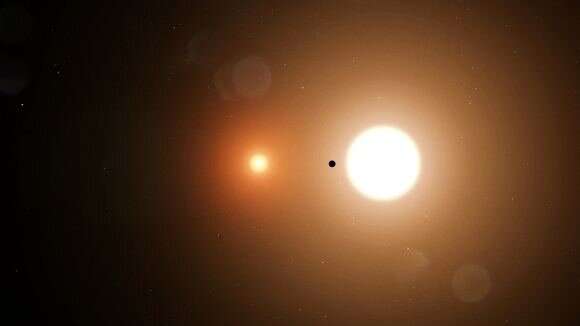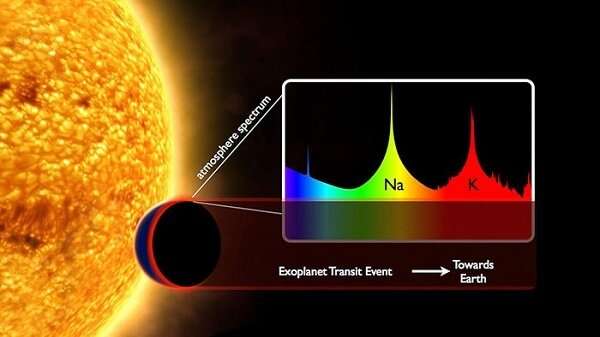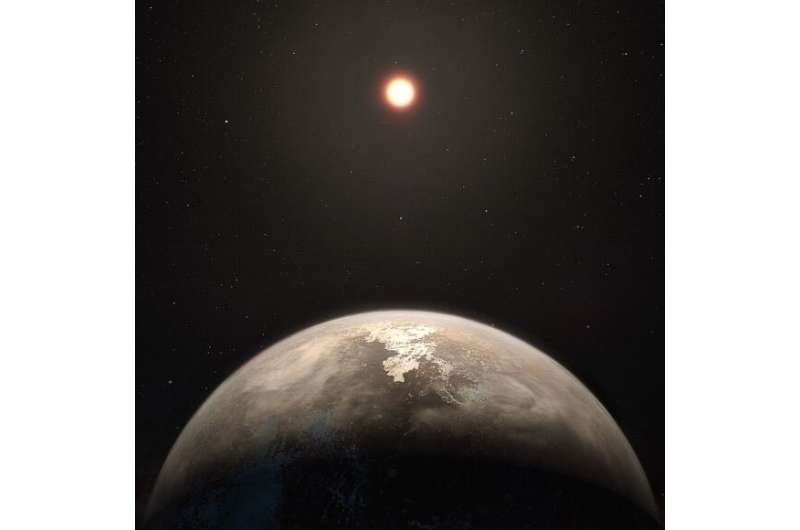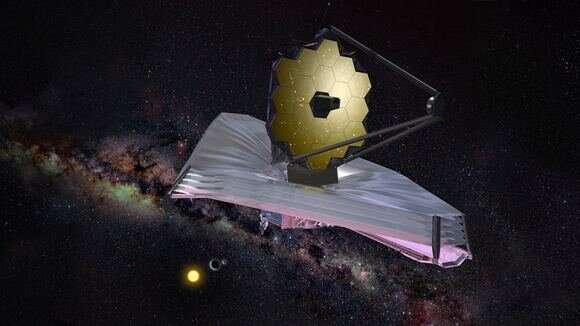TOI 1338 b is a circumbinary planet orbiting its two stars. It was discovered by TESS. Credit: NASA’s Goddard Space Flight Center/Chris Smith
In 2021, NASA's next-generation observatory, the James Webb Space Telescope (JWST), will take to space. Once operational, this flagship mission will pick up where other space telescopes—like Hubble, Kepler and Spitzer—left off. This means that in addition to investigating some of the greatest cosmic mysteries, it will also search for potentially habitable exoplanets and attempt to characterize their atmospheres.
This is part of what sets the JWST apart from its predecessors. Between its high sensitivity and infrared imaging capabilities, it will be able to gather data on exoplanet atmospheres like never before. However, as a NASA-supported study recently showed, planets that have dense atmospheres might also have extensive cloud cover, which could complicate attempts to gather some of the most important data of all.
For years, astronomers have used transit photometry (AKA the transit method) to detect exoplanets by monitoring distant stars for dips in brightness. This method has also proven useful in determining the atmospheric composition of some planets. As these bodies pass in front of their stars, light passes through the planet's atmosphere, the spectra of which is then analyzed to see what chemical elements are present.
So far, this method has been useful when observing massive planets (gas giants and "super-Jupiters") that orbit their suns at great distances. However, observing smaller, rocky planets (i.e., "Earth-like" planets) that orbit closer to their suns, which would put them within the star's habitable zone, has been beyond the capabilities of space telescopes.
For this reason, the astronomical community has been looking forward to next-generation telescopes like the JWST. By examining the spectra of light passing through a rocky planet's atmosphere (a method known as transmission spectroscopy) scientists will be able to look for the telltale indicators of oxygen gas, carbon dioxide, methane, and other signs associated with life (AKA "biosignatures").
As a star’s light filters through a planet’s atmosphere on its way to Earth, the atmosphere absorbs certain wavelengths depending on its composition. Credit: ESO
Another critical element for life as we know it is water, so signatures of water vapor in a planet's atmosphere are a prime target for future surveys. But in a new study led by Thaddeus Komacek, a postdoctoral fellow with the Department of the Geophysical Sciences at the University of Chicago, it is possible that any planet with abundant surface water will also have abundant clouds (particles of condensing ice) in its atmosphere.
For the sake of this study, Komacek and his colleagues examined whether these clouds would interfere with attempts to detect water vapor in the atmospheres of terrestrial exoplanets. Due to the number of rocky exoplanets that have been discovered within the habitable zones of M-type (red dwarf) stars in recent years, like Proxima b, neighboring red dwarfs will be a major focus of future surveys.
As Komack explained to Universe Today via email, tidally locked planets that orbit red dwarf stars are well-suited to studies involving transmission spectroscopy—and for a number of a reasons:
"Transiting planets orbiting red dwarf stars are more favorable targets than those orbiting sun-like stars because the ratio of the size of the planet to the size of the star is larger. The size of the signal in transmission scales as the square of the ratio of the size of the planet to the size of the star, so there's a significant boost in the signal going to smaller stars than Earth.
"Another reason that planets orbiting red dwarf stars are more favorable to observe is because the 'habitable zone," or where we expect there to be liquid water on the surface of the planet, is much closer-in to the star… Because of these closer-in orbits, habitable rocky planets orbiting red dwarf stars will transit their star much more often, which allows observers to take many repeated observations."
Artist’s impression of a habitable exoplanet orbiting a red dwarf star. The habitability of the planets of red dwarf stars is conjectural. Credit: ESO/M. Kornmesser
With this in mind, Komacek and his team employed two models in conjunction to generate synthetic transmission spectra of tidally locked planets around M-type stars. The first was ExoCAM, developed by Dr. Eric Wolf of Colorado University's Laboratory for Atmospheric and Space Physics (LASP), a community Earth-system model (CESM) used to simulate Earth's climate, which has been adapted to study exoplanet atmospheres.
Using the ExoCAM model, they simulated the climate of rocky planets orbiting red dwarf stars. Second, they employed the Planetary Spectrum Generator developed by NASA's Goddard Space Flight Center to simulate the transmission spectrum that the JWST would detect from their simulated planet. As Komacek explained it: "These ExoCAM simulations calculated the three-dimensional distributions of temperature, water vapor mixing ratio, and liquid and ice water cloud particles. We found that planets orbiting red dwarf stars are much cloudier than Earth. This is because their entire dayside has a climate similar to the tropics of Earth, and so water vapor gets easily lofted to low pressures, where it can condense and form clouds that cover much of the dayside of the planet… PSG gave results for the apparent size of the planet in transmission as a function of wavelength, along with the uncertainty. By looking at how the size of the signal changed with wavelength, we were able to determine the size of water vapor features and compare them to the uncertainty level."
Between these two models, the team was able to simulate planets with and without cloud cover, and what the JWST would be able to detect as a result. In the case of the former, they found that water vapor in the exoplanet's atmosphere would almost certainly be detectable. They also found that this could be done for Earth-sized exoplanets in just 10 transits or fewer.
An artist’s illustration of the James Webb Space Telescope, set to launch in March 2021. Credit: NASA/JWST
"[W]hen we included the effects of clouds, the number of transits JWST needed to observe to detect water vapor increased by a factor of 10 to 100," said Komacek. "There is a natural limit on how many transits JWST can observe for a given planet because JWST has a set nominal mission lifetime of five years, and the transmission observation can only be taken when the planet passes between us and its host star."
They also found that the impact of cloud cover was especially strong with slower-rotating planets around red dwarfs. Basically, planets that have orbital periods longer than about 12 days would experience more cloud formation on their daysides. "We found that for planets orbiting a star like TRAPPIST-1 (the most favorable target known), JWST would not be able to observe enough transits to detect water vapor," said Komacek.
These results are similar to what other researchers have noted, he added. Last year, a study led by researchers at NASA Goddard showed how cloud cover would render water vapor undetectable in the atmospheres of the TRAPPIST-1 planets. Earlier this month, another NASA Goddard-supported study showed that clouds will lower the amplitude of water vapor to the point that the JWST would eliminate them as background noise.
But before we go thinking that it's all bad news, this study does present some suggestions for overcoming these limitations. For instance, if mission time is a factor, the JWST mission can be extended so scientists will have more time to gather data. Already, NASA hopes to have the space telescope in operation for 10 years, so a mission extension is already a possibility.
At the same time, a lowered signal-to-noise threshold for detection could allow for more signals to be picked out of the spectra (though that would mean more false positives, as well). In addition, Komacek and his colleagues note that these results apply only to features that are below the cloud deck on exoplanets: "Because water vapor is mostly trapped below the water cloud level, the strong cloud coverage on planets orbiting red dwarf stars makes it incredibly challenging to detect water features. Importantly, it is expected that JWST will still be able to constrain the presence of key atmospheric constituents like carbon dioxide and methane in only a dozen transits or so."
Once again, these results are supported by previous research. Last year, a study from the University of Washington examined the detectability and characteristics of the TRAPPIST-1 planets and found that clouds are not likely to have a significant impact on the detectability of oxygen and ozone features—two key biosignatures that are associated with the presence of life.
So really, the JWST might only have difficulty detecting water vapor in exoplanet atmospheres, at least where dense cloud cover is concerned. The JWST should have no trouble sniffing out other biosignatures, clouds or no clouds. Great things are expected to come from Webb, NASA's most powerful and sophisticated space telescope to date, and it will all start next year.
Source Universe Today



























